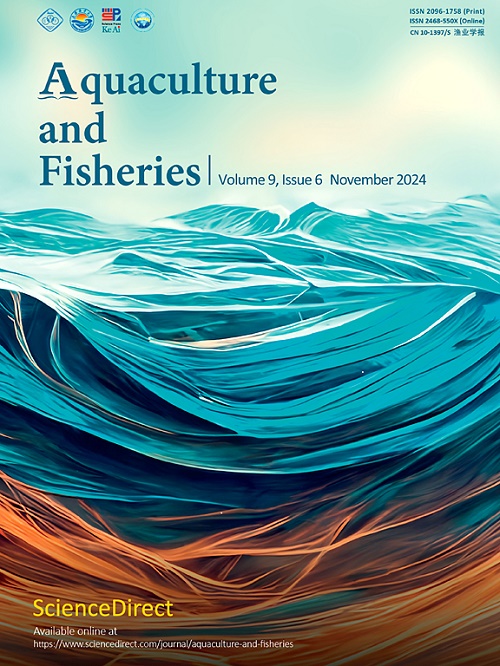西北太平洋小型中上层鱼类、微小浮游生物和鱿鱼脂肪酸成分的地域和物种差异
Q1 Agricultural and Biological Sciences
引用次数: 0
摘要
研究了西北太平洋546种小型中上层鱼类、微鳉和鱿鱼的脂肪酸组成的地理和物种差异。除4种微鳉鱼外,其余种类的优势脂肪酸均为二十二碳六烯酸(DHA)。ω3和ω6脂肪酸以及DHA与二十碳五烯酸(EPA)的比值在不同物种和生物体中存在差异。ω3:ω6和DHA:EPA在小鱼体内的含量普遍低于鱿鱼和小型远洋鱼类。ω3:ω6值东北地区高于西南地区,DHA:EPA值东北地区低于西南地区。脂肪酸组分、DHA:EPA和ω3:ω6的地理差异可能是由环境因素和浮游植物产生的有机质的质量和数量的区域差异引起的。主要脂肪酸成分的非度量多维尺度表现出明显的物种和地理差异。排列多元方差分析显示,小型远洋鱼类、微鳉和鱿鱼之间存在显著差异。这些结果表明,脂肪酸分析可以用于了解不同物种的生态学和生态系统作用。本文章由计算机程序翻译,如有差异,请以英文原文为准。
Geographical and species differences of fatty acid components of small pelagic fishes, micronekton, and squids in the northwestern pacific
Geographical and species differences in fatty acid composition were evaluated among 546 specimens of small pelagic fish, micronekton, and squid in the Northwestern Pacific. For all species except for four micronekton species, the dominant fatty acid was docosahexaenoic acid (DHA). The ratios of ω3 to ω6 fatty acids and DHA to eicosapentaenoic acid (EPA) differed among species and organisms. ω3:ω6 and DHA:EPA were generally lower in micronekton than in squids and small pelagic fishes. The ω3:ω6 values in the northeastern area was higher than that in the southwestern area, meanwhile the DHA:EPA values in the northeastern area was lower than that in the southwestern area. Geographical differences in fatty acid components, DHA:EPA, and ω3:ω6 could have been caused by environmental factors as well as by regional differences in the quality and quantity of phytoplankton-produced organic matter. Non-metric multidimensional scaling of the main fatty acid components showed clear species and geographical differences. A permutational multivariate analysis of variance revealed significant differences among small pelagic fishes, micronekton, and squids. These results indicate that fatty acid analysis can be used to understand the ecology and ecosystem roles of various species.
求助全文
通过发布文献求助,成功后即可免费获取论文全文。
去求助
来源期刊

Aquaculture and Fisheries
Agricultural and Biological Sciences-Aquatic Science
CiteScore
7.50
自引率
0.00%
发文量
54
审稿时长
48 days
期刊介绍:
 求助内容:
求助内容: 应助结果提醒方式:
应助结果提醒方式:


